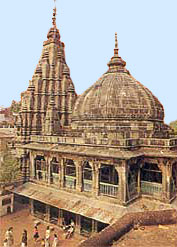Gaya, India
|
Gaya गया |
|
|---|---|
| Metropolitan City | |

Vishnupadh Temple in Gaya, contains footprints of Lord Vishnu
|
|
| Location of Gaya in Bihar | |
| Coordinates: 24°45′N 85°01′E / 24.75°N 85.01°ECoordinates: 24°45′N 85°01′E / 24.75°N 85.01°E | |
| Country |
|
| State | Bihar |
| Region | Magadha |
| Division | Magadh Division |
| District | Gaya |
| Government | |
| • Type | Municipal corporation |
| • Body | Gaya Nagar Nigam |
| • Mayor | Soni Kumari |
| Area | |
| • Total | 90.17 km2 (34.81 sq mi) |
| Elevation | 111 m (364 ft) |
| Population (2011) | |
| • Total | 470,839 |
| • Rank |
98th (India) 2nd (Bihar) |
| • Density | 9,482/km2 (24,560/sq mi) |
| Demonym(s) | Gayaite, Gayavi |
| Languages | |
| • Official | Hindi, English, Urdu |
| Time zone | IST (UTC+5:30) |
| PIN | 823001 - 13 |
| Telephone code | 91-631 |
| ISO 3166 code | IN-BR |
| Vehicle registration | BR 02 |
| Railway Station | Gaya Junction |
| Airport | Gaya International Airport |
| Website |
www |
98th (India)
Gaya (/ɡʌjɑː/) is a city of ancient historical and mythological significance. It is one of the major tourist attractions of Bihar. Gaya is the 2nd largest city of Bihar, and is also the headquarters of Gaya district and Magadh division.
Gaya is 100 kilometres (62 mi) south of Patna, the capital city of Bihar. Situated on the banks of the Phalgu River (or Niranjana, as mentioned in Ramayana), it is a place sanctified by the Jain, Hindu, Islam and Buddhist religions. It is surrounded by small rocky hills (Mangla-Gauri, Shringa-Sthan, Ram-Shila and Brahmayoni) by three sides and the river flowing on the fourth (eastern) side. The city has a mix of natural surroundings, age old buildings, green areas and narrow bylanes.
Gaya finds mention in the great epics, Ramayana and Mahabharata. Rama, along with Sita and Lakshmana, visited Gaya to offer pind-daan to their father Dasharath. In the Mahabharata, the place is referred to as Gayapuri. About the origin of the name ‘Gaya' as referred to in Vayu Purana is that Gaya was the name of a demon (Asura) whose body was pious after he performed rigid penance and secured blessings from Vishnu. It was said that the Gayasura's body would continue to be known as Gaya Kshetra.
...
Wikipedia


